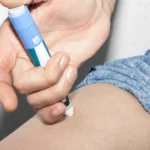
According to a clinical trial, 85% of participants who used Saxenda experienced weight loss throughout the 56-week study. This treatment regimen, which combines Saxenda with a reduced-calorie diet and increased physical activity, has proven high efficacy in managing weight among adult patients. Integrating these elements promotes weight loss and leads to positive outcomes in weight management.
Saxenda, combined with healthy eating habits and regular exercise, offers an effective solution for weight-related concerns in adults and adolescents. Amidst many options, Saxenda stands out due to the safety and efficacy demonstrated in clinical trials. The administration of Saxenda injections highlights its potential as a reliable healthcare option.
This article will provide detailed information about Saxenda’s US FDA approval, clinical trials, efficacy, safety data, and approved indications.
Key Takeaways
- It’s worth noting that the Saxenda schedule helps minimize the potential risks of the medication.
- Saxenda has approved indications for weight management in adults with obesity or overweight conditions with weight-related medical problems.
- Regular follow-up appointments and continuous monitoring of patient progress are crucial for optimizing the balance between the benefits and side effects management with Ssxenda.
- In a Journal of Medical Toxicology article, GLP-1 receptor agonist cases reported to US poison centers were associated with no or minimal effect.
About: Medica Depot is your trusted all-in-one supplier, offering a range of high-quality medical injectables and supplies. If you’re looking to buy Saxenda, our dedicated sales agents can give you proper guidance. We offer a worry-free experience in searching for the best and most popular products on the market. Whether for health professionals, plastic surgeons, dermatologists, licensed estheticians, or other specialists, we can offer genuine, brand-name products you may need. With Medica Depot, we prioritize serving you better to improve the patient’s quality of life.
Clinical Trials and Efficacy Data

Numerous clinical trials have studied the safety and effectiveness of Saxenda in weight loss management. A 56-week Saxenda clinical study involved 3,731 adults, in which three out of five Saxenda-treated patients achieved a significant weight loss of 5% or more.
Meanwhile, a one-year study of teenagers aged 12 to 17 years with obesity revealed that Saxenda, combined with healthy nutrition and physical activity, lowered their BMI-for-age by 0.23. Furthermore, a randomized controlled trial showed that 3.0 mg of liraglutide, diet, and exercise reduced body weight and improved metabolism.
It’s worth noting that the Saxenda schedule helps minimize the potential risks of the medication. While generally safe, patients may expect Saxenda side effects ranging from mild to moderate. The reported common adverse effects include the following:
- Nausea
- Diarrhea
- Constipation
- Vomiting
- Injection site reaction
- Low blood sugar
- Headache
- Upset stomach
- Tiredness
- Dizziness
- Stomach pain
- Change in enzyme levels in your blood
These side effects may subside once the medication adjusts to the body. Moreover, medical professionals may suggest these tips to manage nausea as a Saxenda side effect.
- Eat bland, low-fat foods like crackers, toast, and rice
- Eat foods that contain water, like soups and gelatin
- Avoid lying down after eating
- Go outside to get some fresh air
Approved Indications and Mechanism of Action

Saxenda has approved indications for weight management in adults with obesity or overweight conditions with weight-related medical problems. Moreover, medicla professionals may also prescribe Saxenda to adolescents aged 12 to 17 with obesity.
It’s worth noting that medical practitioners prescribe Saxenda injections combined with a reduced-calorie diet and increased physical activity or regular exercise for weight loss management. Furthermore, Saxenda is a glucagon-like peptide-1 (GLP-1) receptor agonist. This appetite hormone helps regulate the appetite, leading to reduced calorie intake and weight loss.
- Recommended Dosage: The recommended initial dose of Saxenda is 0.6 mg daily in the first week. It requires a weekly increase of 0.6 mg until the recommended dosage of 3 mg is reached.
- Recommended Administration: Inject Saxenda subcutaneously in the abdomen, thigh, or upper arm once daily at any time of the day.
Patient Populations and Considerations


The US Food and Drug Administration has approved Saxenda for adults and adolescents struggling with obesity or overweight. Patients must seek the expertise and guidance of medical practitioners, allowing them to understand these indications and the treatment process.
Adult patients with the following initial body mass index (BMI) can receive Saxenda injections.
- 30 kg/m² or greater (obese), or
- 27 kg/m² or greater (overweight) in the presence of at least one weight-related comorbid condition
Moreover, pediatric patients aged 12 years and older with the following conditions can undergo the treatment:
- body weight above 60 kg, and
- an initial BMI corresponding to kg/m² for adults (obese) by international cut-offs
Medical professionals may not typically prescribe Saxenda for people with certain medical conditions, such as Thyroid C-cell Tumors, Acute Pancreatitis, Acute Gallbladder Disease, Hypoglycemia, etc. These conditions may lead to further complications or increase the risks of severe events.
Regular follow-up appointments and continuous monitoring of patient progress are crucial for optimizing the balance between the benefits and side effects management with Ssxenda. Providers may require a four-month follow-up to address the management of side effects and evaluate the patient’s progress and tolerability.
Post-Marketing Surveillance and Updates
Data from various sources, including the Pharmacovigilance Risk Assessment Committee, have analyzed GLP-1 receptor agonists like Saxenda. They listed that these GLP-1 receptor agonists can treat type 2 diabetes; some also have authorization for weight management.
Furthermore, in a Journal of Medical Toxicology article, GLP-1 receptor agonist cases reported to US poison centers were associated with no or minimal effect. Saxenda already includes two safety data: adults with obesity or overweight concerns and adolescents aged 12 to 17 with obesity.
Additionally, the Saxenda label also includes cardiovascular safety data. According to the American Journal of Managed Care, a LEADER trial showed that 1.8 mg of liraglutide dose did not increase the risks of major cardiovascular events.
To ensure a safe and effective Saxenda treatment, patients should follow the prescribed provider’s recommendations, make necessary lifestyle changes, and report any adverse reactions to their healthcare provider. Visiting for regular follow-ups is also crucial for monitoring treatment progress.
Conclusion
Saxenda, a GLP-1 receptor agonist, has made significant advancements in managing obesity and overweight conditions. Its approval was based on various clinical trials, demonstrating its efficacy in weight loss. The drug regulates appetite, leading to reduced calorie intake and weight loss. It’s approved for adults and adolescents with specific conditions.
Post-marketing surveillance has provided valuable real-world data, reinforcing its safety and effectiveness profile. Since approval, updates on safety or efficacy, including new cardiovascular safety data and approval for adolescent use, have further expanded its use. As practitioners, it’s crucial to consider the patient population, monitor for adverse events, and ensure regular follow-ups for patients on Saxenda.
FAQs
1. What are the main benefits of using Saxenda for weight management?
Saxenda, when combined with a reduced-calorie diet and increased physical activity, has shown high efficacy in weight management. In a 56-week study, 85% of participants experienced weight loss.
2. What are the common side effects of Saxenda?
Common side effects of Saxenda include nausea, diarrhea, constipation, vomiting, injection site reactions, and low blood sugar, among others. These side effects may subside as the body adjusts to the medication.
3. Who is eligible to receive Saxenda injections for weight management?
The US FDA approved Saxenda for adults with obesity or overweight conditions and weight-related medical problems, as well as for adolescents aged 12 to 17 with obesity. It is recommended for patients with a body mass index (BMI) of 30 kg/m² or greater (obese) or 27 kg/m² or greater (overweight) with at least one weight-related comorbid condition.
References
- Benefits of Weight-Loss Medications | Saxenda® (liraglutide) injection 3mg. (n.d.). Www.saxenda.com. Retrieved June 11, 2024, from https://www.saxenda.com/about-saxenda/weight-loss-with-saxenda.html
- Saxenda® liraglutide injection 3mg. (n.d.). Www.novo-Pi.com. Retrieved June 11, 2024, from https://www.novo-pi.com/saxenda.pdf
Clinical aesthetics products refer to a category of products used in the field of medical aesthetics or cosmetic dermatology. These products are typically designed and formulated to be used under the supervision of healthcare professionals, such as dermatologists, plastic surgeons, or trained aestheticians. They are distinct from over-the-counter cosmetics in that they often contain active ingredients or formulations that require expertise in their application or administration.
Examples of clinical aesthetics products include:
-
Dermal Fillers: Injectable substances used to add volume, smooth wrinkles, and enhance facial contours. Examples include hyaluronic acid fillers like Juvederm and Restylane.
-
Botulinum Toxin (Botox): Injectables that temporarily paralyze facial muscles to reduce the appearance of wrinkles caused by repetitive movements, such as frown lines and crow's feet.
-
Chemical Peels: Solutions applied to the skin to exfoliate and improve its texture. They can treat acne, pigmentation issues, and signs of aging.
-
Laser and Light Therapies: Devices that emit focused light or laser energy to treat various skin conditions, including acne, scars, and signs of aging.
-
Prescription Skincare Products: Formulations containing active ingredients like retinoids (vitamin A derivatives), hydroquinone, or prescription-strength antioxidants to address specific skin concerns under medical supervision.






